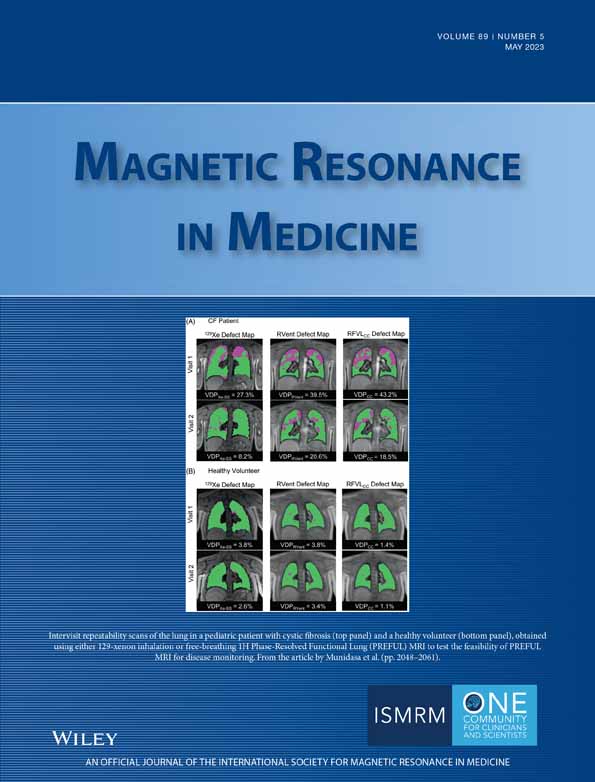Inter- and intravisit repeatability of free-breathing MRI in pediatric cystic fibrosis lung disease
Click here for author-reader discussions
Funding information: Canadian Institutes of Health Research (CIHR) Operating and Project Grant, Grant/Award Numbers: MOP 123431; PJT 153099; Cystic Fibrosis Foundation (CFF), Grant/Award Number: WOODS19A0; Natural Sciences and Engineering Research Council of Canada (NSERC) Discovery Grant (NSERC) Discovery grant, Grant/Award Number: RGPIN 217015-2013; The Hospital for Sick Children
Abstract
Purpose
The purpose of this study is to assess the intra- and interscan repeatability of free-breathing phase-resolved functional lung (PREFUL) MRI in stable pediatric cystic fibrosis (CF) lung disease in comparison to static breath-hold hyperpolarized 129-xenon MRI (Xe-MRI) and pulmonary function tests.
Methods
Free-breathing 1-hydrogen MRI and Xe-MRI were acquired from 15 stable pediatric CF patients and seven healthy age-matched participants on two visits, 1 month apart. Same-visit MRI scans were also performed on a subgroup of the CF patients. Following the PREFUL algorithm, regional ventilation (RVent) and regional flow volume loop cross-correlation maps were determined from the free-breathing data. Ventilation defect percentage (VDP) was determined from RVent maps (VDPRVent), regional flow volume loop cross-correlation maps (VDPCC), VDPRVent ∪ VDPCC, and multi-slice Xe-MRI. Repeatability was evaluated using Bland–Altman analysis, coefficient of repeatability (CR), and intraclass correlation.
Results
Minimal bias and no significant differences were reported for all PREFUL MRI and Xe-MRI VDP parameters between intra- and intervisits (all P > 0.05). Repeatability of VDPRVent, VDPCC, VDPRVent ∪ VDPCC, and multi-slice Xe-MRI were lower between the two-visit scans (CR = 14.81%, 15.36%, 16.19%, and 9.32%, respectively) in comparison to the same-day scans (CR = 3.38%, 2.90%, 1.90%, and 3.92%, respectively). pulmonary function tests showed high interscan repeatability relative to PREFUL MRI and Xe-MRI.
Conclusion
PREFUL MRI, similar to Xe-MRI, showed high intravisit repeatability but moderate intervisit repeatability in CF, which may be due to inherent disease instability, even in stable patients. Thus, PREFUL MRI may be considered a suitable outcome measure for future treatment response studies.
CONFLICT OF INTEREST
Marcus Couch, Robert Grimm, and Ravi Seethamraju are employed by Siemens but did not receive funding for this research




